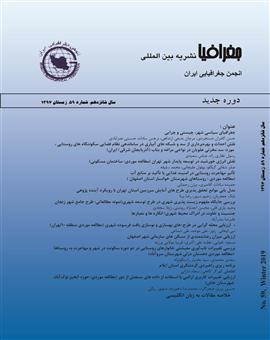مدل یابی موانع تحقق پذیری طرح های آمایش سرزمین استان تهران با رویکرد آینده پژوهی
محورهای موضوعی :بابک جعفریان 1 , رحيم سرور 2 , رضا برنا 3
1 - دانشگاه آزاد اسلامی واحد علوم و تحقیقات تهران
2 - علوم و تحقیقات
3 - علوم انسانی
کلید واژه: آمایش سرزمین تحلیل سارختای مدل¬, سازی ساختاری – تفسیری تحلیل MICMAC استان تهران,
چکیده مقاله :
انوشتار حاضر به دلیل ایجاد درک و دانشی کاربردی برای مسئولان و مدیران استان تهران در زمینه شناسایی و سطح بندی موانع کلیدی بر تحقق-پذیری طرح های آمایش سرزمین در استان تهران، ازنظر هدف گذاری کاربردی و از منظر روش جمع آوری داده ، توصیفی از نوع پیمایشی است. براي انجام اين پژوهش با بررسي جامع و همچنين با استفاده ازنظر خبرگان و متخصصان، 22 عامل مؤثر با استفاده از روش تحلیل ساختاری آینده پژوهی از بین 64 متغیر برای مدل یابی موانع موثر در تحققپذیری طرحهای آمایش سرزمین شناسايي شدند. سپس با استفاده از تكنيك تلفیقی مدل سازي ساختاري تفسيري و با استفاده از ابزار پرسشنامه، عوامل در هشت گروه سطحبندی شدند. در ادامه، پس از مشخص شدن سطوح هريك از عوامل و همچنين با درنظرگرفتن ماتريس در دسترسپذیری نهايي، مدل نهايي ساختاری- تفسيري ترسیمشده است .بر اساس نتايج، عواملي مانند تعدد قوانین و مقررات در ارتباط با آمایش سرزمین، عدم وجود برنامه ریزی راهبردی نهادی در ارتباط با آمایش سرزمین استان، ضعف طرح و برنامه های آمایشی تهیهشده در ارائه الگویی کارآمد برای توسعه پایدار یکپارچه مناطق مختلف استان، عدم حضور ذینفعان و ذینفوذان در فرایند تصمیم گیری و تصمیم سازی در بخش آمایش سرزمین، فقدان قواعد و مقررات مناسب و تفکر نظامند و نهادینه برای مدیریت سرزمین و روشن نبودن جايگاه طرح آمايش استان در نظام برنامهریزی استان تهران جزو متغیر های کلیدی و تأثیرگذار بر عدم تحقق پذیری طرح-های آمایش سرزمین در استان تهران به شمار می روند.
This paper is intended to provide an understanding and practical knowledge for officials of Tehran province in identifying and leveling out the key barriers to the implementation of land design plans in Tehran province from the point of view of applied targeting. From the perspective of data collection method, descriptive Survey type. To conduct this research by comprehensive review and also by experts and experts, 22 effective factors were identified using a structural analysis of futures studies from 64 variables to model effective barriers to the feasibility of land allocation plans. Then, using a combined interpretation technique, interpretive structural modeling and using the questionnaire tool, the factors were ranked in eight groups. Then, after determining the levels of each of the factors and also considering the final availability matrix, the final structural-interpretative model is drawn. Based on the results, factors such as the multiplicity of rules and regulations related to the alignment of the land, the lack of institutional strategic planning In connection with the management of the province's land, the weakness of the plans and plans prepared to provide an effective model for the sustainable development of the various regions of the province, the absence of stakeholders and stakeholders in the decision-making and decision-making process in the area of land administration, the lack of appropriate rules and regulations, and Intelligent and systematic thinking for land management and clarity
